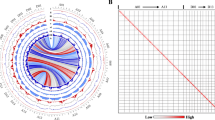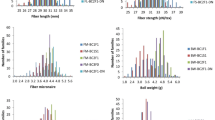Abstract
The current study is the first installment of an effort to explore the secondary gene pool for the enhancement of Upland cotton (Gossypium hirsutum L.) germplasm. We developed advanced-generation backcross populations by first crossing G. hirsutum cv. Tamcot 2111 and G. barbadense cv. Pima S6, then independently backcrossing F1 plants to the G. hirsutum parent for three cycles. Genome-wide mapping revealed introgressed alleles at an average of 7.3% of loci in each BC3F1 plant, collectively representing G. barbadense introgression over about 70% of the genome. Twenty-four BC3F1 plants were selfed to generate 24 BC3F2 families of 22–172 plants per family (totaling 2,976 plants), which were field-tested for fiber elongation and genetically mapped. One-way analysis of variance detected 22 non-overlapping quantitative trail loci (QTLs) distributed over 15 different chromosomes. The percentage of variance explained by individual loci ranged from 8% to 28%. Although the G. barbadense parent has lower fiber elongation than the G. hirsutum parent, the G. barbadense allele contributed to increased fiber elongation at 64% of the QTLs. Two-way analysis of variance detected significant (P<0.001) among-family genotype effects and genotype×family interactions in two and eight regions, respectively, suggesting that the phenotypic effects of some introgressed chromosomal segments are dependent upon the presence/absence of other chromosomal segments.


Similar content being viewed by others
References
Bernacchi D, Beck-Bunn T, Emmatty D, Eshed Y, Inai S, Lopez J, Petiard V, Sayama H, Uhlig J, Zamir D, Tanksley S (1998) Advanced backcross QTL analysis of tomato. II. Evaluation of near-isogenic lines carrying single-donor introgressions for desirable wild QTL-alleles derived from Lycopersicon hirsutum and L. pimpinellifolium. Theor Appl Genet 97:170–180
Bernardo R (2004) What proportion of declared QTL in plants are false? Theor Appl Genet 109:419–424
Bowman DT (2000) Attributes of public and private cotton breeding programs. J Cotton Sci 4:130–136
Bradow JM, Davidonis GH (2000) Quantitation of fiber quality and the cotton production-processing interface: a physiologist’s perspective. J Cotton Sci 4:34–64
Helms AB (2000) Yield study report. In: Dugger P, Richter D (eds) Proc Beltwide Cotton Production Conf. National Cotton Council of America, San Antonio, Tex., pp
Jiang C, Wright R, El-Zik K, Paterson A (1998) Polyploid formation created unique avenues for response to selection in Gossypium (Cotton). Proc Natl Acad Sci USA 95:4419–4424
Jiang C, Chee P, Draye X, Morrell P, Smith C, Paterson A (2000) Multi-locus interactions restrict gene flow in advanced-generation interspecific populations of polyploid Gossypium (Cotton). Evolution 54:798–814
Kloth RH (1998) Analysis of commonality for traits of cotton fiber. J Cotton Sci 2:17–22
Lecomte L, Duffe P, Buret M, Servin B, Hospital F, Causse M (2004) Marker-assisted introgression of five QTLs controlling fruit quality traits into three tomato lines revealed interactions between QTLs and genetic backgrounds. Theor Appl Genet 109:658–668
May OL (2000) Genetic variation for fiber quality. In: Basra AS (ed) Cotton fibers–developmental biology, quality improvement, and textile processing. Food Products Press, New York, pp 183–229
Mei M, Syed NH, Gao W, Thaxton PM, Smith CW, Stelly DM, Chen ZJ (2004) Genetic mapping and QTL analysis of fiber-related traits in cotton (Gossypium). Theor Appl Genet 108:280–291
Meredith MR (2000) Cotton yield progress–why has it reached a plateau. Better Crops 84:6–9
Paterson AH, DeVerna J, Lanini B, Tanksley SD (1990) Fine mapping of quantitative trait loci using selected overlapping recombinant chromosomes, from an interspecies cross of tomato. Genetics 124:735–742
Paterson AH, Saranga Y, Menz M, Jiang C, Wright RJ (2003) QTL analysis of genotype×environmental interactions affecting cotton fiber quality. Theor Appl Genet 106:384–396
Perkins HH, Ethridge DE, Bragg CK (1984) Fiber. In: Kohel RJ, Lewis CF (eds) Cotton. American Society of Agronomy, Madison, pp 438–508
Pillen K, Zacharias A, Leon J (2003) Advanced backcross QTL analysis in barley (Hordeum vulgare L.). Theor Appl Genet 107:340–352
Reinisch AJ, Dong JM, Brubaker C, Stelly D, Wendel JF, Paterson AP (1994) A detailed RFLP map of cotton (Gossypium hirsutum × Gossypium barbadense): chromosome organization and evolution in a disomic polyploid genome. Genetics 138:829–847
Riley CR (1997) Improved high volume instrument elongation measurements. J Cotton Sci 1:61–71
Rong J, Abbey C, Bowers JE, Brubaker CL, Chang C, Chee PW, Delmonte TA, Ding X, Garza JJ, Marler BS, Park CH, Pierce GJ, Rainey KM, Rastogi VK, Schultze SR, Trolinder NL, Wendel JF, Wilkins TA, Williams-Coplin D, Wing RA, Wright RJ, Zhao X, Zhu L, Paterson AH (2004) A 3,347-locus genetic recombination map of sequence-tagged sites reveals features of genome organization, transmission and evolution of cotton (Gossypium). Genetics 166:389–417
SAS Institute (1999) SAS/STAT User’s guide, ver. 8. SAS Institute, Cary, N.C.
Self SG, Liang KL (1987) Asymptotic properties of maximum likelihood estimators and likelihood ratio tests under nonstandard conditions. J Am Stat Assoc 82:605–610
Stephens SG (1946) The genetics of “Corky”. The New World alleles and their possible role as an interspecific isolating mechanism. J Genet 47:150–161
Tanksley SD, Nelson CJ (1996) Advanced backcross QTL analysis: a method for the simultaneous discovery and transfer of valuable QTLs from unadapted germplasm into elite breeding lines. Theor Appl Genet 92:191–203
Thomson MJ, Tai TH, McClung AM, Lai X-H, Hinga EM, Lobos KB, Xu Y, Martinez CP, McCouch SR (2003) Mapping quantitative trait loci for yield, yield components and morphological traits in an advanced backcross population between Oryza rufipogon and the Oryza sativa cultivar Jefferson. Theor Appl Genet 107:479–493
Xiao J, Grandillo S, Ahn S, Yuan L, Tanksley SD, McCouch SR (1996) Genes from wild rice improve yield. Nature 384:223–224
Young ND, Tanksley SD (1989) RFLP analysis of the size of chromosomal segments retained around the Tm-2 locus of tomato during backcross breeding. Theor Appl Genet 77:353–359
Acknowledgements
We acknowledge the financial support from the Texas and Georgia Agricultural Experiment Stations, Texas Higher Education Coordinating Board, Cotton Incorporated, and USDA-IFAFS. XD was a postdoctoral research associate of the Fonds National Belge de la Recherche Scientifique.
Author information
Authors and Affiliations
Corresponding author
Additional information
Communicated by F. Salamini
Electronic Supplementary Material
Rights and permissions
About this article
Cite this article
Chee, P., Draye, X., Jiang, CX. et al. Molecular dissection of interspecific variation between Gossypium hirsutum and Gossypium barbadense (cotton) by a backcross-self approach: I. Fiber elongation. Theor Appl Genet 111, 757–763 (2005). https://doi.org/10.1007/s00122-005-2063-z
Received:
Accepted:
Published:
Issue Date:
DOI: https://doi.org/10.1007/s00122-005-2063-z




